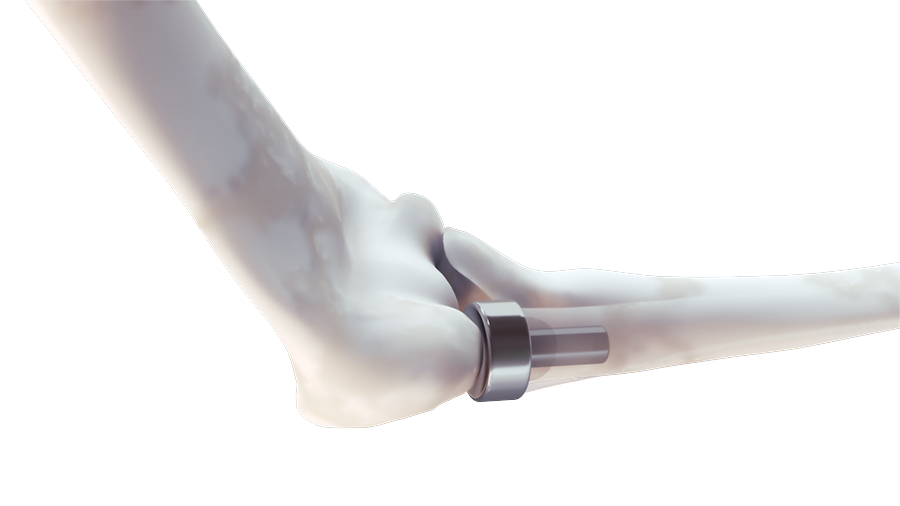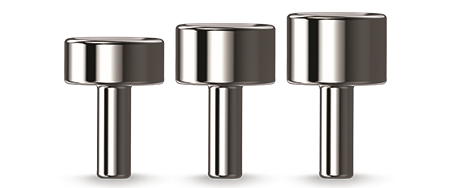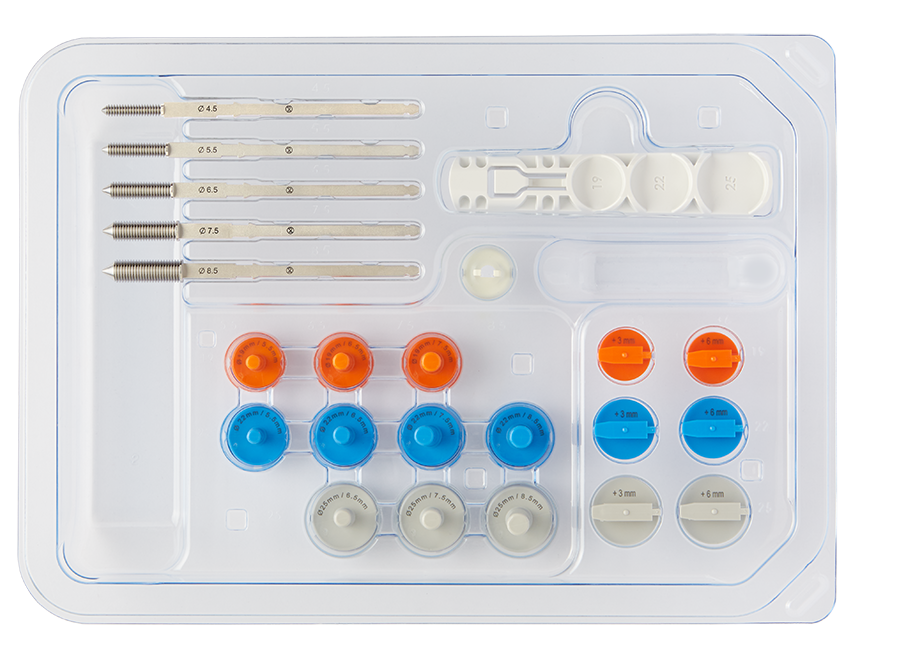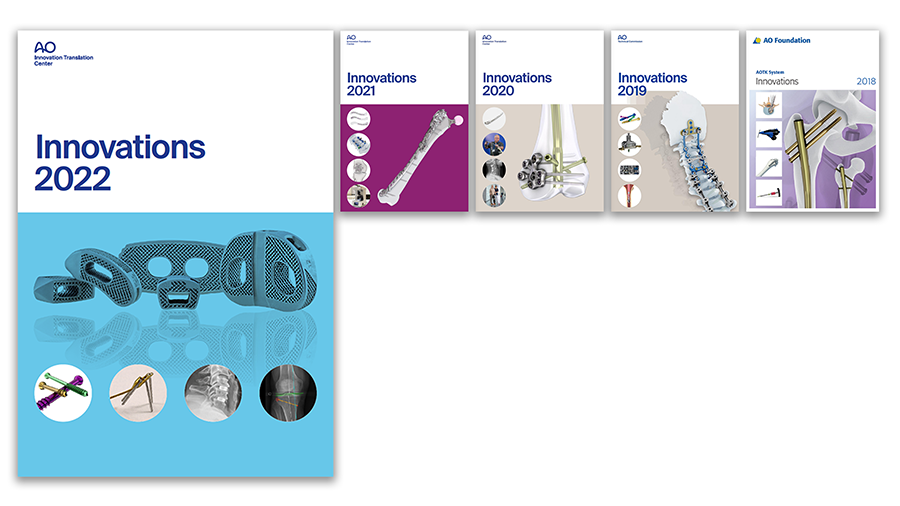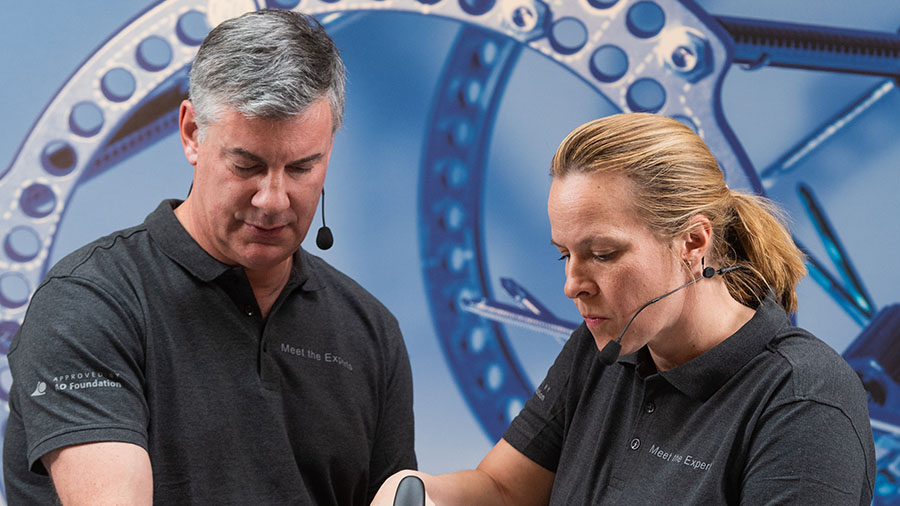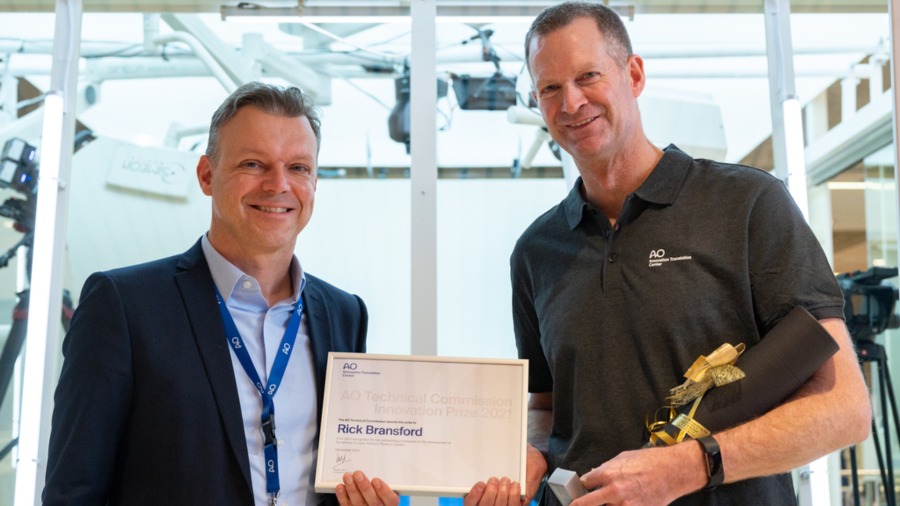
Radial Head Replacement System
The Radial Head Replacement System was approved by the AO Technical Commission in December 2024 as a temporary spacer solution to treat acute radial head trauma including fracture dislocations. The implant (Fig 1) has design features to prevent longitudinal collapse of the radius, allowing associated soft tissue injuries to heal with the radial head in an anatomic position [1].
The Radial Head Replacement System offers 30 different one-piece smooth stem implants options and addresses over 90% of the anatomic range for radial head diameter. The implant array includes three implant head diameters, three head heights and four different stem diameters (Fig 2). The smooth stem design is associated with fewer cases of implant loosening and subsequent removal than press-fit implants [2].
The sterile, single-use instrumentation (Fig 3) aims to improve efficiency, reduce costs, and minimize delays in surgery [3-6], while the radiolucent color-coded trials (Fig 3) are designed for better visualization of the proximal ulna and joint, and allow for in-situ height determination [7]. Further advantages offered by the new system include reduced complexity, and ease of use for surgeons with varying levels of skill and experience.
Indications as approved by the AO Technical Commission
- Temporary spacer following acute trauma to the radial head
Contraindications as approved by the AO Technical Commission
Absolute contraindications include
- infection
- sepsis,
- osteomyelitis
Relative contraindications include
- uncooperative patient or patient with neurologic disorders who are incapable of following directions
- osteoporosis
- metabolic disorders which may impair bone formation
- osteomalacia
- distant foci of infections which may spread to the implant site
- rapid joint destruction
- marked bone loss
- bone resorption apparent on roentgenogram
References
- Chien HY, Chen AC, Huang JW, et al. Short-to medium-term outcomes of radial head replacement arthroplasty in posttraumatic unstable elbows: 20 to 70 months follow-up. Chang Gung Medical Journal. 2010;33(6):668.
- DePuy Synthes Report: Memo Guide Wire Material. 2019. Ref: 0000287828
- R. D. Shippert, "A study of time-dependent operating room fees and how to save $100,000 by using time-saving products," American Journal of Cosmetic Surgery, vol 22, no. 1, pp. 25-34, 2005
- Traverso LW, Hargrave K. A prospective cost analysis of laparoscopic cholecystectomy. Am J Surg. 1995; 169;503-506.
- Anwar F, Shoaib RF. Critical incident identification in common orthopaedic injury. JPMA. The Journal of the Pakistan Medical Association. 2009;59(2):71-74
- McCormack J. Satisfy surgeons by improving instrument turnaround time. Materials management in health care. 1995;4
- DePuy Synthes Report: See Better Size Better Memo. 2019. Ref: 0000290188.
Hazards and labeling
Due to varying countries’ legal and regulatory approval requirements, consult the appropriate local product labeling for approved intended use of the products described on this website. All devices on this website are approved by the AO Technical Commission. For logistical reasons, these devices may not be available in all countries worldwide at the date of publication.
Legal restrictions
This work was produced by AO Foundation, Switzerland. All rights reserved by AO Foundation. This publication, including all parts thereof, is legally protected by copyright.
Any use, exploitation or commercialization outside the narrow limits set forth by copyright legislation and the restrictions on use laid out below, without the publisher‘s consent, is illegal and liable to prosecution. This applies in particular to photostat reproduction, copying, scanning or duplication of any kind, translation, preparation of microfilms, electronic data processing, and storage such as making this publication available on Intranet or Internet.
Some of the products, names, instruments, treatments, logos, designs, etc referred to in this publication are also protected by patents, trademarks or by other intellectual property protection laws (eg, “AO” and the AO logo are subject to trademark applications/registrations) even though specific reference to this fact is not always made in the text. Therefore, the appearance of a name, instrument, etc without designation as proprietary is not to be construed as a representation by the publisher that it is in the public domain.
Restrictions on use: The rightful owner of an authorized copy of this work may use it for educational and research purposes only. Single images or illustrations may be copied for research or educational purposes only. The images or illustrations may not be altered in any way and need to carry the following statement of origin “Copyright by AO Foundation, Switzerland”.
Check www.aofoundation.org/disclaimer for more information.
If you have any comments or questions on the articles or the new devices, please do not hesitate to contact us.
“approved by AO Technical Commission” and “approved by AO”
The brands and labels “approved by AO Technical Commission” and “approved by AO”, particularly "AO" and the AO logo, are AO Foundation's intellectual property and subject to trademark applications and registrations, respectively. The use of these brands and labels is regulated by licensing agreements between AO Foundation and the producers of innovation products obliged to use such labels to declare the products as AO Technical Commission or AO Foundation approved solutions. Any unauthorized or inadequate use of these trademarks may be subject to legal action.
AO ITC Innovations Magazine
Find all issues of the AO ITC Innovations Magazine for download here.
Innovation Awards
Recognizing outstanding achievements in development and fostering excellence in surgical innovation.


